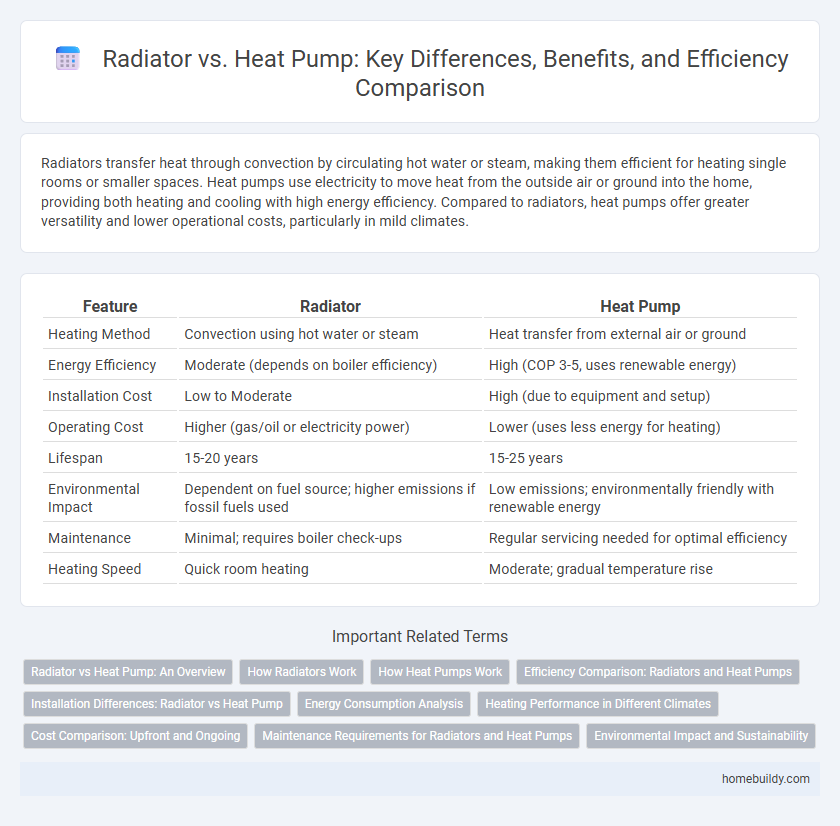Radiators transfer heat through convection by circulating hot water or steam, making them efficient for heating single rooms or smaller spaces. Heat pumps use electricity to move heat from the outside air or ground into the home, providing both heating and cooling with high energy efficiency. Compared to radiators, heat pumps offer greater versatility and lower operational costs, particularly in mild climates.
Table of Comparison
| Feature | Radiator | Heat Pump |
|---|---|---|
| Heating Method | Convection using hot water or steam | Heat transfer from external air or ground |
| Energy Efficiency | Moderate (depends on boiler efficiency) | High (COP 3-5, uses renewable energy) |
| Installation Cost | Low to Moderate | High (due to equipment and setup) |
| Operating Cost | Higher (gas/oil or electricity power) | Lower (uses less energy for heating) |
| Lifespan | 15-20 years | 15-25 years |
| Environmental Impact | Dependent on fuel source; higher emissions if fossil fuels used | Low emissions; environmentally friendly with renewable energy |
| Maintenance | Minimal; requires boiler check-ups | Regular servicing needed for optimal efficiency |
| Heating Speed | Quick room heating | Moderate; gradual temperature rise |
Radiator vs Heat Pump: An Overview
Radiators transfer heat through convection and radiation using hot water or steam circulated from a boiler, providing consistent, radiant warmth ideal for colder climates. Heat pumps use electricity to transfer heat from the outside air or ground into a building, offering higher energy efficiency and cooling capabilities year-round. While radiators excel in delivering stable, localized heat, heat pumps present a modern, eco-friendly solution with lower operational costs and versatile temperature control.
How Radiators Work
Radiators function by transferring heat from hot water or steam circulating inside their metal panels to the surrounding air through convection and radiation. Unlike heat pumps that extract ambient heat from outside air or ground, radiators rely on a centralized boiler system to generate thermal energy. Their design maximizes surface area for efficient heat distribution, making them effective for indoor heating in traditional hydronic systems.
How Heat Pumps Work
Heat pumps operate by transferring heat from the outside air or ground into indoor spaces using a refrigeration cycle, making them highly energy-efficient for both heating and cooling. Unlike radiators that emit heat through direct conduction or convection from hot water, heat pumps rely on compressors and refrigerants to absorb and release thermal energy. Their ability to reverse the process allows for versatile temperature regulation, contributing to reduced energy consumption compared to traditional radiator systems.
Efficiency Comparison: Radiators and Heat Pumps
Radiators transfer heat through convection and radiation, typically relying on a boiler system that burns fuel or uses electricity, with efficiencies often ranging from 70% to 90%. Heat pumps operate by extracting heat from ambient air, ground, or water, achieving higher efficiency with coefficients of performance (COP) between 3.0 and 5.0, meaning they deliver 3 to 5 units of heat per unit of electricity consumed. The superior efficiency of heat pumps results in lower energy consumption and reduced greenhouse gas emissions compared to traditional radiator systems, making them a more sustainable heating option.
Installation Differences: Radiator vs Heat Pump
Radiator installation typically involves fitting a network of pipes connected to a central boiler, requiring wall space for each radiator unit and integration with existing plumbing systems. Heat pump installation demands setting up an outdoor compressor unit and indoor air-handling or hydronic components, often requiring less extensive pipework but suitable space for external equipment. Radiators usually necessitate modifications to internal walls for pipe routing, while heat pumps may require electrical upgrades to support higher power loads.
Energy Consumption Analysis
Radiators typically consume more energy than heat pumps because they rely on combustion or electric resistance to generate heat, leading to higher operational costs and carbon emissions. Heat pumps use electricity to transfer heat efficiently, often delivering up to three times more heat energy than the electrical energy they consume, making them a more energy-efficient choice. Energy consumption analysis shows that heat pumps reduce overall energy usage by leveraging ambient heat, whereas radiators require continuous fuel or electrical input to maintain temperature.
Heating Performance in Different Climates
Radiators provide consistent and efficient heating in colder climates by directly warming the air and surfaces in a room, making them ideal for areas with prolonged winter seasons. Heat pumps perform optimally in moderate climates due to their reliance on ambient air temperatures, with efficiency dropping significantly in extreme cold. Choosing between a radiator and a heat pump for heating performance depends heavily on the local climate's temperature range and seasonal variations.
Cost Comparison: Upfront and Ongoing
Radiators typically have a lower upfront cost compared to heat pumps, which require a significant initial investment due to their complex installation and equipment. However, heat pumps often provide greater energy efficiency, resulting in reduced ongoing operating costs and lower utility bills compared to traditional radiator systems. Over time, the higher initial expense of heat pumps can be offset by savings in energy consumption and maintenance.
Maintenance Requirements for Radiators and Heat Pumps
Radiators require regular bleeding to remove trapped air and periodic inspection for leaks or corrosion to maintain efficient heat transfer. Heat pumps demand routine filter cleaning, coil maintenance, and occasional refrigerant level checks to ensure optimal performance and energy efficiency. Both systems benefit from annual professional servicing, but heat pumps typically involve more complex maintenance tasks due to their mechanical components.
Environmental Impact and Sustainability
Radiators primarily rely on fossil fuel-based boilers, resulting in higher carbon emissions compared to heat pumps, which use electricity to transfer heat efficiently with minimal greenhouse gas output. Heat pumps significantly reduce environmental impact by utilizing renewable energy sources and maintaining high energy efficiency, leading to lower carbon footprints and enhanced sustainability. Choosing heat pumps over traditional radiators supports climate goals by cutting reliance on non-renewable energy and promoting eco-friendly heating solutions.
Radiator vs Heat Pump Infographic

 homebuildy.com
homebuildy.com